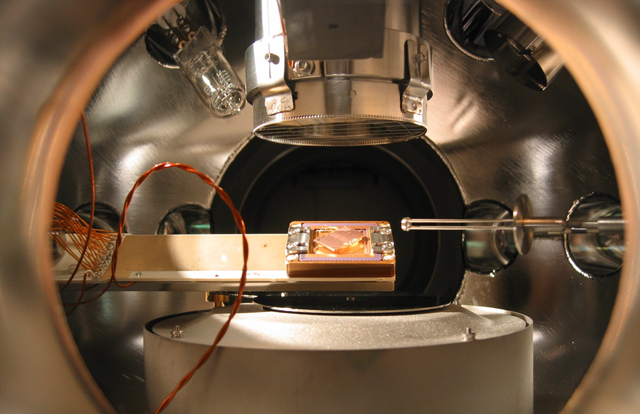Perpetual Motion Test Could Amend Theory of Time

In February 2012, the Nobel Prize-winning physicist Frank Wilczek decided to go public with a strange and, he worried, somewhat embarrassing idea. Impossible as it seemed, Wilczek had developed an apparent proof of “time crystals” — physical structures that move in a repeating pattern, like minute hands rounding clocks, without expending energy or ever winding down. Unlike clocks or any other known objects, time crystals derive their movement not from stored energy but from a break in the symmetry of time, enabling a special form of perpetual motion.
“Most research in physics is continuations of things that have gone before,” said Wilczek, a professor at the Massachusetts Institute of Technology. This, he said, was “kind of outside the box.”
Wilczek’s idea met with a muted response from physicists. Here was a brilliant professor known for developing exotic theories that later entered the mainstream, including the existence of particles called axions and anyons, and discovering a property of nuclear forces known as asymptotic freedom (for which he shared the Nobel Prize in Physics in 2004). But perpetual motion, deemed impossible by the fundamental laws of physics, was hard to swallow. Did the work constitute a major breakthrough or faulty logic? Jakub Zakrzewski, a professor of physics and head of atomic optics at Jagiellonian University in Poland who wrote a perspective on the research that accompanied Wilczek’s publication, says: “I simply don’t know.”
Now, a technological advance has made it possible for physicists to test the idea. They plan to build a time crystal, not in the hope that this perpetuum mobile will generate an endless supply of energy (as inventors have striven in vain to do for more than a thousand years) but that it will yield a better theory of time itself.
A Crazy Concept
The idea came to Wilczek while he was preparing a class lecture in 2010. “I was thinking about the classification of crystals, and then it just occurred to me that it’s natural to think about space and time together,” he said. “So if you think about crystals in space, it’s very natural also to think about the classification of crystalline behavior in time.”
When matter crystallizes, its atoms spontaneously organize themselves into the rows, columns and stacks of a three-dimensional lattice. An atom occupies each “lattice point,” but the balance of forces between the atoms prevents them from inhabiting the space between. Because the atoms suddenly have a discrete, rather than continuous, set of choices for where to exist, crystals are said to break the spatial symmetry of nature — the usual rule that all places in space are equivalent. But what about the temporal symmetry of nature — the rule that stable objects stay the same throughout time?
Wilczek mulled over the possibility for months. Eventually, his equations indicated that atoms could indeed form a regularly repeating lattice in time, returning to their initial arrangement only after discrete (rather than continuous) intervals, thereby breaking time symmetry. Without consuming or producing energy, time crystals would be stable, in what physicists call their “ground state,” despite cyclical variations in structure that scientists say can be interpreted as perpetual motion.
“For a physicist, this is really a crazy concept to think of a ground state which is time-dependent,” said Hartmut Häffner, a quantum physicist at the University of California, Berkeley. “The definition of a ground state is that this is energy-zero. But if the state is time-dependent, that implies that the energy changes or something is changing. Something is moving around.”
How can something move, and keep moving forever, without expending energy? It seemed an absurd idea — a major break from the accepted laws of physics. But Wilczek’s papers on quantum and classical time crystals (the latter co-authored by Alfred Shapere of the University of Kentucky) survived a panel of expert reviewers and were published in Physical Review Letters in October 2012. Wilczek didn’t claim to know whether objects that break the symmetry of time exist in nature, but he wanted experimentalists to try to make one.
“It’s like you draw targets and wait for arrows to hit them,” he said. “If there’s no logical barrier to this behavior being realized, then I expect it will be realized.”
The Big Test
In June, a group of physicists led by Xiang Zhang, a nanoengineer at Berkeley, and Tongcang Li, a physicist and postdoctoral researcher in Zhang’s group, proposed creating a time crystal in the form of a persistently rotating ring of charged atoms, or ions. (Li said he had been contemplating the idea before reading Wilczek’s papers.) The group’s article was published with Wilczek’s in Physical Review Letters.
Since then, a single critic — Patrick Bruno, a theoretical physicist at the European Synchrotron Radiation Facility in France — has voiced dissent in the academic literature. Bruno thinks Wilczek and company mistakenly identified time-dependent behavior of objects in excited energetic states, rather than their ground states. There is nothing surprising about objects with surplus energy moving in a cyclical fashion, with the motion decaying as the energy dissipates. To be a time crystal, an object must exhibit perpetual motion in its ground state.
Bruno’s comment and Wilczek’s reply appeared in Physical Review Letters in March 2013. Bruno demonstrated that a lower energy state is possible in a model system that Wilczek had proposed as a hypothetical example of a quantum time crystal. Wilczek said that although the example is not a time crystal, he doesn’t think the error “calls into question the basic concepts.”
“I proved that example is not correct,” Bruno said. “But I have no general proof — so far, at least.”
The debate will probably not be settled on theoretical grounds. “The ball is really in the hands of our very clever experimental colleagues,” Zakrzewski said.
An international team led by Berkeley scientists is preparing an elaborate lab experiment, although it may take “anywhere between three and infinity years” to complete, depending on funding or unforeseen technical difficulties, said Häffner, who is co-principal investigator with Zhang. The hope is that time crystals will push physics beyond the precise but seemingly imperfect laws of quantum mechanics and lead the way to a grander theory.
“I’m very interested in seeing if I can make a new contribution following Einstein,” Li said. “He said that quantum mechanics is not complete.”
To Build an Ion Ring
In Albert Einstein’s theory of general relativity (the body of laws governing gravity and the large-scale structure of the universe), the dimensions of time and space are woven together into the same fabric, known as space-time. But in quantum mechanics (the laws governing interactions on the subatomic scale), the time dimension is represented in a different way than the three dimensions of space — “a disturbing, aesthetically unpleasant asymmetry,” Zakrzewski said.
The different treatments of time may be one source of incompatibility between general relativity and quantum mechanics, at least one of which must be altered for there to be an all-encompassing theory of quantum gravity (widely viewed as a major goal of theoretical physics). Which concept of time is right?
If time crystals are able to break time symmetry in the same way that conventional crystals break space symmetry, “it tells you that in nature those two quantities seem to have similar properties, and that ultimately should reflect itself in a theory,” Häffner said. This would suggest that quantum mechanics is inadequate, and that a better quantum theory might treat time and space as two threads of the same fabric.
The Berkeley-led team will attempt to build a time crystal by injecting 100 calcium ions into a small chamber surrounded by electrodes. The electric field generated by the electrodes will corral the ions in a “trap” 100 microns wide, or roughly the width of a human hair. The scientists must precisely calibrate the electrodes to smooth out the field. Because like charges repel, the ions will space themselves evenly around the outer edge of the trap, forming a crystalline ring.
At first, the ions will vibrate in an excited state, but diode lasers like those found in DVD players will be used to gradually scatter away their extra kinetic energy. According to the group’s calculations, the ion ring should settle into its ground state when the ions are laser-cooled to around one-billionth of a degree above absolute zero. Access to this temperature regime had long been obstructed by background heat emanating from trap electrodes, but in September, a breakthrough technique for cleaning surface contaminants off electrodes enabled a 100-fold reduction in ion trap background heat. “That’s exactly the factor we need to bring this experiment into reach,” Häffner said.
Next, the researchers will switch on a static magnetic field in the trap, which their theory says should induce the ions to start rotating (and continue doing so indefinitely). If all goes as planned, the ions will cycle around to their starting point at fixed intervals, forming a regularly repeating lattice in time that breaks temporal symmetry.
To see the ring’s rotation, the scientists will zap one of the ions with a laser, effectively tagging it by putting it into a different electronic state than the other 99 ions. It will stay bright (and reveal its new location) when the others are darkened by a second laser.
If the bright ion is circling the ring at a steady rate, then the scientists will have demonstrated, for the first time, that the translational symmetry of time can be broken. “It will really challenge our understanding,” Li said. “But first we need to prove that it does indeed exist.”
Until that happens, some physicists will remain deeply skeptical. “I personally think it’s not possible to detect motion in the ground state,” Bruno said. “They may be able to make a ring of ions in a toroidal trap and do some interesting physics with that, but they will not see their ever-ticking clock as they claim.”
This article was reprinted on Wired.com.



